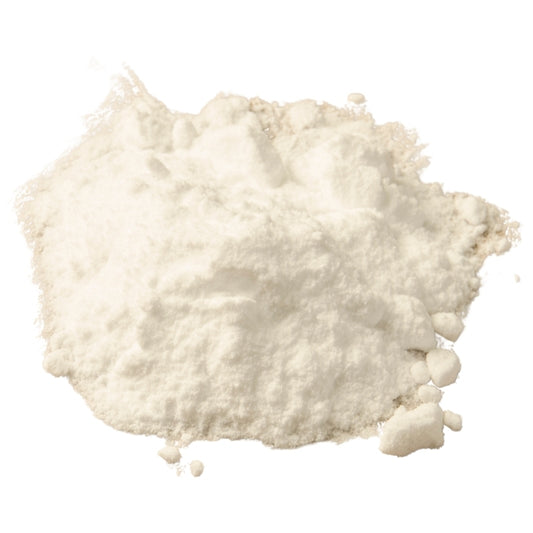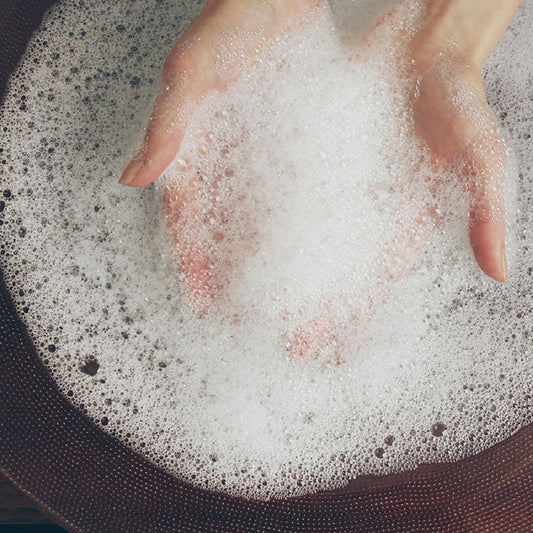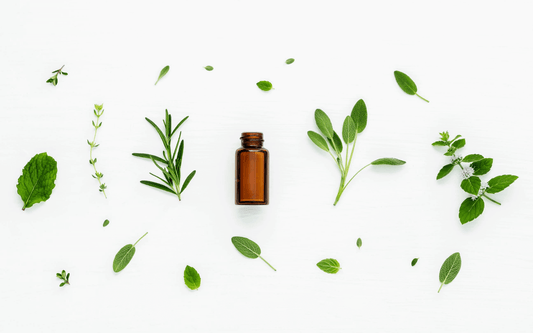
Beginners’ DIY: Everything You Need To Know To Get Started
Juliette van der MeerEvery week we share a new entry into the Essentially Natural Blog, with informational articles, free formulations and how-to guides. But what if you're a complete newbie with no idea where to even start? We thought we'd make this blog just for you: everything you need to know to get started on DIY!
Equipment
Firstly, let's get you set up with equipment that you will need. Many items may be in your kitchen already.
We recommend having a couple of beakers of different sizes, a scale with an accuracy of 0.01g, silicone spatulas and some metal spatula spoons, glass bowls, an electric beater and a blender for blending, and also a microwave or stove for heating.
A thermometer and pH meter or pH strips are also useful.
Please check out our guide to Setting Up Your DIY Lab for more info.
Terms
Ok you've got your equipment at the ready, what's next? Here are some commonly used terms and their meanings, which you will come across in DIY and formulating.
- Anhydrous - this means the product contains no water. Examples of anhydrous products are an oil serum, a powder facial cleanser, a soothing balm, etc.
- Aqueous/water phase - the water phase where water and all water-based ingredients go together. Sometimes it will be necessary to heat the water phase.
- Emulsifier - brings oils and water together to form a lotion or cream. You'll need an emulsifier if you want to mix oils and water together, or mix oil-based ingredients and water-based ingredients together.
- Emulsion - in DIY cosmetics an emulsion can be a lotion, cream, body butter or anything where oils and water have been forced to mix together with the aid of an emulsifier.
- Formulation - the recipe or formula for making the product.
- Oil phase - the oil phase where all oils and oil-soluble ingredients go together (including butters and emulsifiers, etc). Sometimes it will be necessary to heat the oil phase.
Check out our DIY Encyclopedia for more common terms and their meanings!
Now that you know some terms and their meanings, let's get into the basics of a formula. Formulation is like a jigsaw puzzle where you have to fit all the pieces together. You can also think of it in cooking or baking terms, where you build your cake by adding ingredients in a certain way.
There are three main building blocks to a typical formulation:
- The oil phase which contains all the oil-based ingredients.
- The water phase which contains all the aqueous ingredients.
- The cool down phase which contains the preservative, certain actives and any heat sensitive ingredients such as essential oils.
Depending on the type of product you are making, it may have all three phases, two phases, or even only one phase.
Ingredient Classes
Next up, you need to learn about ingredient classes. Ingredient classes are broad categories that all ingredients will fall under.
- Butters - butters are solid plant-based fats with lovely moisturising properties for the skin. Other functions in a formula: adding viscosity
- Oils - plant-based oils pressed from different parts of plants, with numerous properties and benefits for the skin. Other functions in a formula: thinning out viscosity.
- Essential oils - aromatic compounds of plants. Essential oils add scent and therapeutic properties to formulations.
- Preservatives - essential to give your product a shelf life and keep it from going off. Preservatives are necessary in all formulas containing water. Strictly speaking you don't need a preservative in anhydrous formulas, but you may want to consider the storage environment and other factors such as fingers in the jar, etc. Preservatives typically go in the cool down phase of a formulation (are added at a temperature below 35 degrees).
- Humectants - add moisture and hydration. Also useful functional ingredients to dissolve gelling agents with. Examples are hyaluronic acid, honey, vegetable glycerine, propanediol and lactic acid.
- Hydrosols - a by-product of the essential oil steam distillation process. Hydrosols are a useful water replacement and usually have nice scents and some properties of the essential oil.
- Emulsifiers - to unify oils and water into an emulsion. Emulsions are more advanced so decide if you just want to first play around with anhydrous and water formulations before combining the two and needing an emulsifier.
- Waxes - waxes are occlusive agents, adding a protective barrier to the skin. They are optional in most formulations but can be useful to add occlusiveness, viscosity, hardness and stability to a formula.
- Thickeners - thickeners thicken up formulations and can include gelling agents, fatty acids or even butters.
- Surfactants - surfactants or surface active agents are the cleansers and foamy agents in formulations. You'll need surfactants if you want to make foaming cleansers, hand wash, body wash, shampoo, bubble bath, etc.
- Stabilisers - gelling agents and fatty acids can also act as formulation stabilisers.
- Clays - clays include kaolin clay, bentonite clay, rhassoul clay. They are great for facial masks, cleanser and soaps.
- pH adjusters - pH adjusters can adjust the pH of the formulation up or down. Some common pH adjusters are citric acid, baking soda, lactic acid and sodium hydroxide.
- Actives - actives are a broad class of ingredients that include vitamins, acids and specialised ingredients that act on deeper levels of the skin.
More fun things: colourants, exfoliants, powders, botanicals, solubilisers, antioxidants, etc.
As a starting point, we would recommend having the following ingredients on hand:
A butter like avocado butter, an oil such as almond oil, a preservative such as Geogard 221, a humectant like veg glycerine or propanediol, a hydrosol, an emulsifier such as Eco E wax if you want to try emulsions, xanthan gum as a thickening and stabilising agent, a surfactant if you want to make a cleanser, a clay if you want to do a mask, and then you can choose if you want to play with actives and fun things.
How To Write A Formula
In cosmetics we work in percentages, which is nice as it can be converted into any unit of measurement. Think of 100% as 100g or 100ml (choose your unit of measure and keep it constant throughout your formula; we prefer to work in grams but if you want to work in mils you can). Therefore if you have ingredients at 65%, 5%, 15% etc, that means you measure out 65g/ml, 5g/ml, 15g/ml. There is a direct correlation between the % amount and the measured amount.
When working in percentages, the final amount must always add up to 100 as 100% is the max amount you can get. So check your formula that everything adds to 100!
If you want to make an amount larger or smaller than 100g or 100ml, then simply multiple or divide the measurement amount by the multiplier. For example if you want a 500g batch of cream, multiple all the measurement amounts by 5 (100 x 5 = 500), or if you want a 50g batch, then divide by 2 (100 / 2 = 50).
Here's an example of scaling up a formula:
original 100g batch new 500g batch ( x 5)
70% | 70g water 70% | 350g water
19% | 19g oil 19% | 95g oil
5% | 5g butter 5% | 25g butter
5% | 5g emulsifier 5% | 25g emulsifier
1% | 1g preservative 1% | 5g preservative
Total: 100% | 100g Total: 100% | 500g
How To Start Formulating
Now that you know about ingredients and percentages, it's time to start putting them all together into a formula. Follow these rules:
- Decide on a type of product you'd like to make, and research it; what properties does it have, how should it behave and what should it do, what are typical ingredients that go into it.
- Then start by looking up the usage instructions of ingredients on the product pages, and decide or check for what phase to add the ingredient to (oil, water or cool down), check the usage rate, and other things like solubility, pH, heat sensitivity etc. Note everything down. If an ingredient doesn't have a set usage rate (eg. an oil or hydrosol), then it is often helpful to work backwards: start with the usage rates you do know and then see what % is left to be filled in. The % must always add to 100%
- Make a formulation table with the phase, ingredient, usage rate and any other special instructions
Formulating is like fitting the puzzle pieces (ingredients) together into their respective places (phases) so that you can see the bigger picture (the final formulation).
Here, we've done an example formulation following the steps:
- The product we want is a basic body lotion. This is slightly technical but you'll get a good idea of what to do for your future formulations.We know a lotion is a type of emulsion so it will have a water phase, an oil phase (including an emulsifier), and it will need a preservative because there is water (so therefore a cool down phase because preservatives are typically added at cool down). We want the cream to absorb well and be moisturising.
- Because we know there's a water, oil and cool down phase and it's an emulsion, we already know that there are going to be at least 4 ingredients: water or a water based ingredient, an oil + an emulsifier, and a preservative. We decide to use a hydrosol instead of just plain water as our water phase. A hydrosol doesn't have a set usage rate so we can use any amount, and it is obviously water soluble. We decide to use rice bran oil as our oil of choice because we like its properties and it is rich in Vitamin E which is great for skin. We use Eco E wax as our emulsifier at 5%, and we use Geogard 221 as our preservative at 1%. We decide to also include a stabiliser in the form of xanthan gum. From reading on the product page, it is found that xanthan gum can be used from 0.1-1%, is water soluble, and is hydrated for easier dispersion in a bit of vegetable glycerine (which happens to be a water-soluble humectant so this is great for a lotion). We'll use the xanthan gum at 0.5% and the glycerine at 2%
- After filling in the spaces with the info we know our table will now look like this:
|
Phase (water, oil, cool down; or A, B, C) |
Ingredient name/INCI |
Used at % |
Special instructions |
|
A | heated water phase |
Rose hydrosol |
x% We decide to make this 68.5% |
Water soluble |
|
A | water phase |
Xanthan gum |
0.5% |
Water soluble |
|
A | water phase |
Vegetable glycerine |
2% |
Water soluble |
|
B | heated oil phase |
Rice bran oil |
x% We decide to make this 23% |
Oil soluble |
|
B | heated oil phase |
Eco E wax (an emulsifier) |
5% |
Oil soluble; has to be melted with the oil phase |
|
C | cool down phase |
Geogard 221 (a preservative) |
1% |
Has to go in cool down phase |
We know you must be wondering about the arbitrary amounts of the oil and hydrosol used. Please read our Quick Guide to Emulsifiers to fill in the knowledge gap on the ratios of oil to emulsifier which is beyond the scope of this blog. The amount of hydrosol can then be worked out in order to add to 100%.
OK we have a formulation! All you have to do is make it, and you already know the phases of where everything goes. We start with our water phase by blending the xanthan gum and vegetable glycerine together, then adding that to the hydrosol and blending. Melt the oil and emulsifier together, and then bring the temperature of the water phase up to a similar range as that of the melted oil phase. Get your stick blender and blend the oil and water phases together. You should see them starting to turn white and emulsify into a lotion consistency. Lastly add in the preservative ince the emulsion has cooled.























4 comments
Hi Kulthum
We are so glad that you found this blog useful!
If you do find that you’d like more information on a specific topic, let us know – and we’ll see what we can do for you :)
Kind Regards,
Aiden
Thank you. Much appreciated.
I totally agree with you, Jacky, this is truly amazing and a great help for newbies like me. Greatly appreciated, Essentially Natural.
Thank you so much for this valuable information. I am so impressed that you would care enough to help us along in this DIY journey!! 🤗🤗